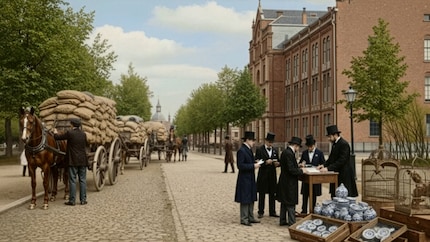
News + Trends
Zurich presents first AI actress - Hollywood reacts in horror
by Luca Fontana

What’s in store for us after the launch of AI actress Tilly Norwood? Studio Particle6 is now using algorithms to generate its take on the past for the History Channel. The result? A perfectly staged, but soulless rendering of history.
A few weeks ago, an AI actor shook up the movie world. Tilly Norwood, a synthetic 24-year-old spawned by Particle6 has become a symbol of an industry that no longer knows where algorithms begin and art ends.
So what’s next? The studio’s taking things further, having launched a format on the Dutch History Channel that’s re-enacting the past with the help of AI, of course.
«Straten van Toen» (Streets of the Past) is the name of the new short series first mentioned by the Hollywood Reporter. It also happens to be Particle6’s most ambitious experiment to date. It aims to combine historical analysis, archive footage and AI into a single, seamless and uncanny mix.
The Dutch author, historian and reality star Corjan Mol (known from The Curse of Oak Island) has a leading role. In each episode, he visits a famous street or an iconic spot in the Netherlands in the year 1650. Or 1880. Or basically whenever something important happened there. So far, so typical for history TV.

What’s new is that all backdrops and scenery, including people and effects, haven’t been produced by an expensive company, but by Particle6’s AI for a fraction of the cost. The algorithm’s fully recreated the setting based on paintings, engravings and old photographs. In other words, it’s been fed with archives used to visually reconstruct the past in a way that only expensive VFX studios can do.
Corjan Mol appears in the AI-generated scenes, thereby becoming a historical witness – or at least a witness to what a machine believes to be history. At the end of each episode, he then reflects on what influence the event shown has had on present-day Netherlands. It’s the only fully human moment in a production that otherwise feels like a field test for the future.
Producer Eline van der Velden told THR that Particle6 has been working with AI for some time, both in research and post-production, but this is the first series in which AI also plays a major role on screen. «Monitored by humans, of course,» she emphasises. At the same time, she calls the format a potential blueprint for historical TV of the future.
And so we’ve come full circle with Tilly Norwood.
All of a sudden, Particle6 has reached a point where its AI can replace not only actors, but also costume designers, model makers, set designers, camerawomen, sound men, lighting experts, make-up artists and everything a production like this requires. In addition, Particle6 delivers finished results in significantly less time and effort.
No wonder they’re cheaper.
This is precisely why «Straten van Toen» seems like a demonstration of power. A statement that AI’s becoming more than a mere backdrop to an imitation of time and alleged reality; it’s replacing humans, too. Mol, the historian who reflects each episode at the very end, is the last human anchor in this AI machinery. And he might just become a tragic figure: the last witness to a past that’s now completely under the control of the algorithm.
AI not only changes processes, it also shifts the balance of power. Not because it’s «better», but because it’s faster, cheaper and tireless – and therefore economically enticing. Once companies realise that an algorithm can replace not just actors, but entire departments and therefore cut costs, there will be consequences.
Having said that, AI can be hugely valuable as a tool. For example, when it takes on the work that robs people of time, energy and creativity. It only turns into a threat when it starts to take over creativity, too. Without a vision, or intuition, or meaning. Especially for professions that have long been considered irreplaceable and exclusively human.
But Norwood and the like are just the tip of the iceberg. On TikTok and Instagram, for example, Bigfoot has been producing adventure vlogs while cats are caught shooting up guided missiles. Let’s not kid ourselves: the age of AI production has long since begun – and with it an era of a perfectly staged but potentially soulless reality.
I write about technology as if it were cinema, and about films as if they were real life. Between bits and blockbusters, I’m after stories that move people, not just generate clicks. And yes – sometimes I listen to film scores louder than I probably should.
From the latest iPhone to the return of 80s fashion. The editorial team will help you make sense of it all.
Show all